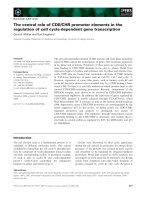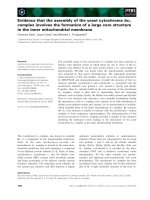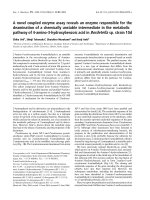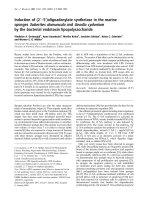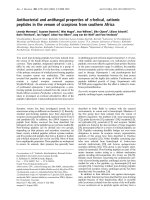Natural regeneration of evergreen broad leaved forest in the thuong tien nature reserve kim boi district hoa binh province
Bạn đang xem bản rút gọn của tài liệu. Xem và tải ngay bản đầy đủ của tài liệu tại đây (816.6 KB, 57 trang )
ABSTRACT
To evaluate the current situation as well as research on the natural regeneration in
Thuong Tien nature reserve, I have conducted fieldwork, observation in the reserve. Survey
data through high tree, shrub and regeneration tree class in the study site. Mainly statistic
some information necessary to serve for the processing of data such as: name species, average
height, status and origin of trees. The research was performed from 31 July, 2015 in Thuong
Tien nature reserve. Based on results obtained I conducted data processing to bring out the
results as: formula composition of high trees and regeneration trees, calculate the density of
trees, phenotypic of distributions regeneration trees, origin of regeneration trees and number
of regeneration prospects. In addition, show relationship between high trees and regeneration
trees class. To improve the efficiency of research, I have based on the following purposes: (1)
investigated the status of regeneration at Thuong Tien nature reserve; (2) statistic about the
characteristics natural regeneration in the study site. This research is the best way to evaluate
the natural regeneration of evergreen broad - leaved forest. The findings of this research will
provide an important scientific basis to serve the in-depth study into the problem of forest
regeneration as well as assistance in finding the best way to manage forests in Vietnam.
TABLE OF CONTENT
CHAPTER I. INTRODUCTION ............................................................................................................ 1
CHAPTER II. LITERATURE REVIEW ................................................................................................ 2
2.1. Basic concepts .................................................................................................................................. 2
2.1.1. Forest regeneration ........................................................................................................................ 2
2.1.2. Forms of forest regeneration ......................................................................................................... 2
2.2. Study in foreign countries ................................................................................................................ 3
2.2.1. Research on natural regeneration .................................................................................................. 3
2.2.2. Survey methods for natural regeneration ...................................................................................... 3
2.3. Study in domestic ............................................................................................................................. 5
2.3.1. Research on natural regeneration .................................................................................................. 5
2.3.2. Survey methods for natural regeneration ...................................................................................... 6
2.4. Conclusion........................................................................................................................................ 6
CHAPTER III. GOALS AND OBJECTIVES ........................................................................................ 8
CHAPTER IV. STUDY SITES AND METHODS................................................................................. 9
4.1. Natural conditions ............................................................................................................................ 9
4.1.1. Geographical location, boundary .................................................................................................. 9
4.1.2. Topography ................................................................................................................................. 11
4.1.3. Climate and hydrology ................................................................................................................ 11
4.2. Characteristics of livelihood, economic and social ........................................................................ 14
4.2.1. Livelihood ................................................................................................................................... 14
4.2.2. Economic and social.................................................................................................................... 15
4.3. Study site ........................................................................................................................................ 15
4.5. Survey methods .............................................................................................................................. 17
4.5.1. Determined forest status .............................................................................................................. 17
4.5.2. Trees investigation ...................................................................................................................... 17
4.5.3. High trees investigate .................................................................................................................. 18
4.5.4. Shrub investigate ......................................................................................................................... 19
4.5.5. Regeneration trees investigate ..................................................................................................... 19
4.6. Data processing methods ................................................................................................................ 20
4.6.1. Method determine the composition regeneration trees ............................................................... 20
4.6.2. Determine the phenotypic of distribution regeneration trees ...................................................... 21
4.6.3. Statistical methods for the quality of regeneration trees ............................................................. 22
CHAPTER V. RESULTS AND DISCUSSION ................................................................................... 23
5.1. Current status of evergreen broad - leaved forest........................................................................... 23
5.2. High trees ....................................................................................................................................... 23
5.3. Shrub layer ..................................................................................................................................... 26
5.4. Regeneration trees class ................................................................................................................. 26
5.4.1. The composition regeneration trees ............................................................................................ 26
5.4.2. Phenotypic of distributions regeneration trees: ........................................................................... 28
5.4.4. Quality of regeneration trees: ...................................................................................................... 30
5.4.5. Regeneration prospects: .............................................................................................................. 31
5.4.6. Relationship between of high trees and regeneration trees class................................................. 33
CONCLUSION ..................................................................................................................................... 37
6.1. Current status of evergreen broad - leaved forest........................................................................... 37
6.2. High trees and shrubs ..................................................................................................................... 37
6.2.1. High trees .................................................................................................................................... 37
6.2.2. Shrub ........................................................................................................................................... 37
6.2.3. Regeneration trees ....................................................................................................................... 37
REFERENCES ...................................................................................................................................... 36
APPENDICES....................................................................................................................................... 37
LISTS OF TABLE
Table 4.1. Bioclimate index ...................................................................................................... 12
Table 4.2. Categories of forest in Thuong Tien ........................................................................ 16
Table 4.3. Data summary of high tree floor ............................................................................. 18
Table 4.4. Data summary of regeneration trees class ............................................................... 19
Table 5.1. Phenotypic of distributions index ............................................................................ 28
Table 5.2. Statistics numbers of tree follows origin and height level ..................................... 29
Table 5.3. Rate of quality of regeneration trees ....................................................................... 31
Table 5.4. Rate of regeneration prospects ................................................................................ 31
Table 5.5. Relationship between of high trees and regeneration trees class ........................... 35
LISTS OF FIGURE
Figure 4.1. Map of study site in Thuong Tien nature reserve .................................................. 10
Figure 4.2. Bioclimate diagrams of Kim Boi – Hoa Binh ........................................................ 13
Figure 4.3. Structure of the sample plot diagram ..................................................................... 17
Figure 4.4. Location of research area ....................................................................................... 18
Figure 5.1. Regeneration trees and division according to height levels and origin .................. 30
Figure 5.2. Rate of regeneration prospects in both 3 plots ....................................................... 32
CHAPTER I. INTRODUCTION
Thuong Tien nature reserve located in Kim Boi district is a reserve of evergreen broad
- leaved forest on Limestone Mountains. Total area of 7308 hectares (ha) includes: forested
area about 4894 (ha), natural area about 4657 (ha) and 237 (ha) plantations forest, nonforested land 1254 (ha). Nature reserve is also one of the few areas with remaining natural
forest area of Hoa Binh province and the Northwest, with vegetation at lower elevations on
the mountain land (˂ 700 m). Therefore, the reserve is one of places have important role
protect this valuable ecosystem.
There are some of gymnosperms appear in the reserve such as: Taxus wallichiana
(Thông đỏ), Podocarpaceae (Thông tre), and some species are threatened at the global level
as: Vatica cinerea (Táu mật) – EN (Endangered), Excentrodendron tonkinensis (Nghiến) –
EN (Endangered), Amoora dasyclada (Gội đỏ) – VU (Vulnerable), and some endangered
species in Vietnam are listed in Viet Nam Red Book as: Fernandoa bracteata (Đinh vàng),
Vatica subglabra (Táu nước), Excentrodendron tonkinensis (Nghiến). Characteristic of the
nature reserve is tropical rain evergreen forest with rich flora.
In fact, research of natural regeneration of the forest is a topic, which has interested
scientists. There have been numerous of research on the diversity of flora and fauna, however,
Study about the structure, regeneration dynamics, mechanism for maintaining biodiversity
and resilience of natural forests has not been so attracted. The purpose of the research was to
determine composition of regeneration, quantity, quality, phenotypic of distributions
regeneration trees on ground and follow vertical aspect as scientific basis to find best of
solution suited for forest management. Starting from that, I was carried out a thesis on this
issue: “Natural regeneration of evergreen broad - leaved forest in the Thuong Tien
nature reserve, Kim Boi district, Hoa Binh province”.
1
CHAPTER II. LITERATURE REVIEW
2.1. Basic concepts
2.1.1. Forest regeneration
According to Phung Ngoc Lan (1986) forest regeneration is a biological process and
has characteristics of forest ecosystems. A specific characteristic of the forest regeneration is
appearing of new generation of the wood species in the forest, where there are circumstances:
under the forest canopy, hole in the forest, forest land after mining, forest land after
cultivation and harvest. The role of seedlings is replacing old trees. Therefore, forest
regeneration, can understand like the process to recover the basic components of forest,
mainly wood floors. Features of natural regeneration were many scientists around the world to
conduct research to establish a scientific basis and reasoning for serve in the forestry business.
Overall, tropical forest regeneration is very complex, not many research and largely
concentrated in a number of species with economic value.
2.1.2. Forms of forest regeneration
Researchers on forest regeneration divided two major forms of regeneration:
continuous regeneration and streak regeneration.
a. Continuous regeneration: because of climatic conditions suitable for the combination of
complex species, age of species lead to regeneration periods occurred around the year.
However, only the shade-tolerant species in small stages can survive under the forest canopy.
In this period the seedlings often weak, slow growth. When conditions are favorable lead to
small tree can growth, participate in the high trees floor and rapid development.
b. Streak regeneration (hole regeneration): especially for species adapted to light and
frequent occurs in older primary forests. When large trees are dead, some of space has enough
light will facilitate the process of strong regeneration. The regeneration trees are mainly
composed species adapted to light, rapid growth, short life, softwood or develop from seeds
already in the soil, or brought from other places. These are mainly holes regeneration. After
creating the canopy, shade tolerant plants in the primeval forest appearing and developing,
2
then gradually overwhelms species adapted to light and participated in components of high
tree floor in the forest.
2.2. Study in foreign countries
2.2.1. Research on natural regeneration
In the world, some studies show that a common type of regeneration of tropical forests
is continuous regeneration. Van Steenis showed tropical forest have composition complex in
high trees floor, because different age trees of populations lead to regeneration taking place
throughout the year. Only shade tolerant plants in small stages are able to survive under the
forest canopy.
Conversely, the authors studied about natural regeneration of tropical forests in Asia
as Bava (1954), Budowski (1956) has identified under the canopy of tropical forests generally
have a sufficient number of tree regeneration have economic value. Therefore need some of
silvicultural measures necessary to ensure the development and regeneration is available
under the forest canopy.
The study of Nava (1954), Budowski (1956) also showed its ability of regeneration
under the canopy of the tropical rainforest depends greatly on the level of species and species
diversity. Another common characteristic of regeneration in rainforest suitable with species
adapted to light is hole regeneration.
The appearances of the hole in the rainforest make change conditions include: light,
humidity and temperature under the forest canopy, according to Van Steenis (1956),
composition of tree species grow in holes regeneration is the species fast growing, adapted to
light, usually short-lived and not appear in forest composition caused by origin starting from
far or bought from other places by animal, human.
2.2.2. Survey methods for natural regeneration
Establish square plot with the area: 25m2, investigating the regeneration trees have
economic value (diameter 1 - 2.5cm) origin from the seeds and have good condition.
According to Lamprecht (1989) established the plot investigate high tree with the area:
2.500m2 (50m x 50m), one circle sub – plot with the area: 707m2 (d = 30m) have center of
3
sub - plot coincide with the center of plot for investigated seedlings, trees with diameter at
breast height <10cm and height greater than 1.3m. Established 12 different sub - plot with the
area of each sub - plot: 4m2 (2m x 2m) arranged in two transect perpendicular through the
center of the plot to investigate tree with height 0.3m - 1.3m.
Setting up an area of investigation 10.000m2 (1ha) and established 25 plot, each plot
have area: 400m2 (20m x 20m), each corner of the plot up a sub-plot has an area of 25m2 (5m
x 5m) to investigate seedlings. This method was evaluated with high precision and
particularly suitable for the regeneration ecological research should have been used
extensively in studies regeneration in the tropical rainforest.
According to Sapkota and Oden, set up one plot with area: 25m2 (5m x 5m) have
center is the intersection of two diameters are used when determining the area of the hole
diameter and investigation all the seedlings at height ≥ 2m and one sub – plot have area 4m2
(2m x 2m) is set up in the corner of plot to measure the diameter of the root all the seedlings
with a height at 0.2 - 2m, simultaneously measuring the height and diameter of all the trees in
diameter at breast height > 20cm around the hole.
According to Jans et al (1993), Nanf và Wulf (2007), hole area is determined by
dividing the hole under the small triangle with joint vertices in hole, measure the distance and
azimuth respectively from the center hole to the point on the edge of plot in the surrounding
forest. Accordingly, the authors selected 8 positions at the edge of the hole corresponding to
the azimuth 0, 45, 90, 135, 180, 225, 270, 315 with the center hole and the distance from the
center to 8 points. These points are connected to each other and in center hole created
polygons with 8 triangles. The total area of 8 main triangle is area of hole and set up one sub plot with area 25m2 (5m x 5m) in each triangle to investigate the characteristics of tree
regeneration.
4
2.3. Study in domestic
2.3.1. Research on natural regeneration
Research on natural regeneration in Vietnam is just beginning in the 1960s. The
process of regeneration is a biological process with specific characteristics of forest
ecosystems. Regeneration tree is replacing old tree generation. In Vietnam, regeneration also
has the general characteristics of tropical forest, but is complicated by the impact of human.
The process of continuously regenerated not only occur in primary forests but also in
secondary forest. Natural regeneration appear even in the most plantations are in areas with
good soil. Formula composition of regeneration associated with the composition of high trees
because regeneration tree is the next generation under the canopy of high tree floor and have
affected by the seeding of high tree floor, or development of buds on the roots of trees or
development based on the seeds brought from other place.
According to Thai Van Trung (1963, 1970, and 1978) has confirmed: Natural
regeneration of tropical forests in northern Vietnam also have the characteristics of tropical
forest regeneration. Continuous regeneration of shade tolerant species under the forest canopy
and hole regeneration of the photophilic species.
Research in Yen Bai, Ha Tinh, Quang Binh and Lang Son according to Do Thi Ngoc
Le (2007) shows a layer structure regeneration associated with high trees, one tree species
have high coefficient of high tree floor composition will have similar coefficients in the
composition of regeneration class.
According to Vu Dinh Hue has divided regeneration into 3 levels: good regeneration
has density >12000 trees/ha, medium regeneration has density 4000 – 8000 trees/ ha, bad
regeneration has density 2000 – 4000 trees/ ha. However, this study only focuses on the
density of regeneration tree.
Hole regeneration is one of the common characteristics of the natural forest
regeneration, when assessing the distribution of regeneration tree by level height Ta Thi
5
Huong (2009), Nguyen Thi Kha (2009) have concluded: like with the regeneration under the
canopy, the amount of regeneration in the holes decrease when their height increases.
2.3.2. Survey methods for natural regeneration
According to Do Thi Ngoc Le (2007): numbers of plot multiple but the investigation
area of each plot is not large so accuracy is not high. From there the author for that set up 5
plot, each plot has an area of 25m2 (5m x 5m) with 4 sub - plot located in the 4 corners of the
sample plots, the remaining were set in position two diagonal intersection of plot. Despite
have less numbers of plot but large areas should research results with high accuracy.
According to Hoang Thi Tuyet (2010): on each forest status, establishment 1 plot in
typical location has an area of 10.000 m2 (100m x 100m) and 25 sub - plots which has an area
of 400m2 (20m x 20m). Then randomly selected 13 sub - plots in the 25 sub - plots to collect
the detail information.
According to Tran Van Con (2010): when studying regeneration in one plot has area
10.000m2 (1ha), author use 2 types of plot to investigate regeneration, in which has one circle
plot (radius = 15m and area = 707m2) for investigated D1.3 from 1 to 10cm and 12 sub – plots
with area: 4m2 (2m x 2m) for investigated D1.3 <1cm.
According to normative silviculture QPN 14-92 of Forestry Ministry and now
Ministry of Agriculture and Rural Development, regeneration prospect of natural forests in
Vietnam is generally have height at 1-2m upward. Most authors have identified regeneration
prospect tree have height is equal to or exceeds the height of the shrub layer and average
quality growth or better.
2.4. Conclusion
The research of natural regeneration is quite diverse and rich in content, methods and
subjects studied. Research results helped to clarify the issues of forest regeneration. So my
thesis focuses on the following issues:
i. Investigated the status of regeneration at Thuong Tien nature reserve.
6
ii. Statistic about the characteristics natural regeneration in the study site.
From the base of the different research methods, my thesis was refer and use of
sampling methods according to the system of Lowdermilk (1927):
i. Establish plots with an area of 1000m2/plot (40m x 25m)
ii. Area of sub-plot in plot is 4m2/subplot (2x2m)
iii. The area of the sub-plot needs to facilitate the investigation process in order to reflect the
realities of regeneration.
iv. Addition, in the process of complete the thesis also uses some of tools to serve the
investigation process to collect data as: tape measure (50m), compass, GPS.
7
CHAPTER III. GOALS AND OBJECTIVES
Goals:
Determine characteristics of natural regeneration of evergreen broad-leaf forest in the
Thuong Tien nature reserve.
Objectives:
1.Investigated the status of natural forest at Thuong Tien nature reserve.
2.Statistic about the characteristics natural regeneration in the study site.
Contents:
Current status of evergreen broad-leaf forest in Thuong Tien reserve:
i. Classify the forest status
ii. Elevation
iii. Total area
iv. Basic structure of the forest
• High trees (name species, formula composition)
• Shrub trees (name species, height average)
Characteristics of the natural regeneration class
• Name species.
• Formula composition.
• Origin and quality of regeneration trees.
• Density of regeneration.
• Phenotypic of distributions regeneration trees.
• Regeneration prospects.
8
CHAPTER IV. STUDY SITES AND METHODS
Study site
4.1. Natural conditions
4.1.1. Geographical location, boundary
Thuong Tien nature reserve is the first protected area was established in the Hoa Binh
province with Decision 94/CT dated 09/08/1986 of the Chairman of the Council of Ministers,
nature reserve with a total area of 7308(hectares). Located in the administrative boundaries of
three communes: Thuong Tien, Kim Tien - Kim Boi district and Quy Hoa - Lac Son district.
Abutting on the North: Hop Dong, Dong Bac, Vinh Tien, Tu Son (Lac Son district).
Abutting on the East: Kim Binh, Kim Boi, Kim Truy và Cuoi Ha (Kim Boi district)
Abutting on the South: Tuan Dao, My Thanh (Lac Son district)
Abutting on the West: Xuan Phong, Yen Thuong, Yen Lap (Cao Phong district)
Thuong Tien nature reserve located in areas with geographic coordinates:
From 1050 20' to 1050 30' East longitude
From 200 30' to 200 40' North latitude
9
Figure 4.1. Map of study site in Thuong Tien nature reserve
10
4.1.2. Topography
Topography of Thuong Tien nature reserve characterized by mountains system with an
elevation from 300 - 1000 m above sea level. The highest point in the nature reserve reaches
1,073 m (Cot Ca peak), which is also the highest mountain in the reserve. The forest area of
reserve mainly located in area with the high slope, with two mountain ranges divided: Cot Ca
ranges and Cot Co ranges, only a small forest area is relatively flat located in between two
communes: Quy Hoa and Thuong Tien. Topography deep, dump in the river, narrow, rock,
creating rugged terrain and largely this territory in the slope above 350.
4.1.3. Climate and hydrology
Thuong Tien nature reserve is located under the tropical monsoon climate region with
cold winters, rainy summer, and dry period from 2.1 to 3.0 months. This is one of the high
rainfall areas of Hoa Binh province and the upper catchment of the Boi river and Buoi river.
The monitoring data of Hydrometeorology Station in Kim Boi (20040’ North latitude,
105032’ East longitude) shows, a long of rainy season from April to October, concentration
on 90.38% of the total of rainfall throughout the year.
Northeast monsoon regularly in winter, make nature reserve have dry season no clearly as
Northwest, simultaneously form the low temperature, high air humidity and drizzle rain.
i.Southwest monsoon causing hot dry early summer and rain after that.
ii.Southeast monsoon blows from East Sea, popular in the last summer and early fall,
causing rain for the reserve.
The influence of three air masses has created relatively mild climate without month
drought. The long dry season from November last year until March next year, with three dry
months (rainfall ≤ 2 times of the average monthly temperature) is the December, January and
February. Climate conditions are very suitable for the growth and development of
regeneration trees. The annual average rainfall is about 1,600 mm/year and is influenced by 3
main wind directions.
11
The average humidity of the study area: 85%, highest humidity 89% and lowest
humidity 80%. The average temperature of the area is 230C, with highest temperature is 290C,
lowest temperature is 100C. In Cot Ca peak and Thung hill, frost may have formed in a short
time in the coldest day. In general, the climate of the Thuong Tien nature reserve create
advantage conditions for many plants and animals grow and develop, formed one diversified
and stable nature reserve.
Below is a bioclimatic diagram of Kim Boi district, Hoa Binh province (references
from 2000):
Table 4.1. Bioclimate index
I
II
III
IV
V
VI
VII
VIII
IX
X
23.8
26.8
27.8
28.0
27.4
26.3
23.6
XI
XII
T
15.7 16.9 20.0
R
32.8 27.9 46.6 110.3 252.1 307.8 337.3 350.5 433.3 247.5 87.0 23.1 2256.6
ΔT
6.9
5.8
60
7.2
8.7
8.3
8.4
7.7
7.8
8.2
8.1
8.1
7.6
U
84
85
86
85
83
84
84
86
86
84
82
81
84
S
-
-
-
-
-
-
-
-
-
-
-
-
-
12
20.2 17.2
Years
22.8
Figure 4.2. Bioclimate diagrams of Kim Boi – Hoa Binh
a. Name of recording station: Kim Boi
b. Altitude of location: 100 m
c. Number of years of observation: temperature: 24years and precipitation: 26years
d. Mean annual total temperature in degree centigrade: 22.80C
e. Mean annual total of precipitation in mm: 2256 mm
f. Mean daily minimum of temperature in coldest month: 13.00C
g. Absolute temperature minimum: 2.10C
h. Mean daily maximum of temperature in warmest month: 33.10C
i. Absolute temperature maximum: 40.50C
13
j. Mean temperature range: 7.60C
k. a: dry period for plant growth period
l. b: humid period
m. c: per – humid period
n. d: period during with mean daily minimum temperature of month is lower than 150C
o. e: period during with absolute daily minimum temperature is lower than 50C
p. f: precipitation
q. g: temperature
Most hydrological system of Thuong Tien nature reserve has 4 large river systems and
small streams with interlaced system, have water around of year, with Thuong Tien stream
flowing into the Boi River towards Southeast. There are some other small streams flowing
into Lac Son district in the South of the reserve. This is the main sources water supply to the
communes in area of Kim Boi district and Lac Thuy district. Through statistics show that the
use of water for agriculture of the two districts downstream Lac Thuy and Kim Boi mainly
depends on water of Boi River. However, the rainy season often causes floods affecting traffic
system in area. This is one of the issues should be studied for contribute to regulating the
water of downstream through the management and use of watershed forests.
4.2. Characteristics of livelihood, economic and social
4.2.1. Livelihood
The population: Thuong Tien nature reserve located in the administrative boundaries
of three communes included 2089 households, with 10641 people, the number of people
depends on agriculture about 9914 people (93.2%), and number of people depends on other
trades about 727 people (6.8%).
The ethnic: in an area with two main ethnic are Muong ethnic accounting for 97.1%
and other ethnic groups including the Kinh, Thai and Tay ethnic accounting for 2.9% of all
peoples of the region.
14
The labor: the whole region has 4535 employees, mainly depends on agriculture have
4130 people accounting for 91.07%, the remaining employees depends on other trades.
4.2.2. Economic and social
Manufacturing activity in the region mainly is agriculture, the main income of the
people are from farming and raising livestock and poultry. The life of the local people were
difficult, the average food income is 285 kg / person / year.
The poverty rate of the communes in the reserve is high, with 52.8% in Thuong Tien
commune, 50% at Kim Tien commune and 70.2% Quy Hoa commune. In particular, Tien
Thuong commune belong to 135 programs.
The economic structure in recent years has been changing but not much. The transition
is associated with tourism development and service activities. Especially Kim Boi have huge
potential about tourism development such as Kim Boi mineral water parks, and other tourist
sites such as: Mat Troi waterfall in Kim Tien commune, Cuu waterfall in Tu Son commune
and resort in Vinh Yen. The transformation of economic structure can help improve the live
conditions of local people, to reduce the impact of agriculture on forests in Thuong Tien
nature reserve.
4.3. Study site
Mostly is special use forest and not affected by external factors.
Total area of Thuong Tien nature reserve about 7308(ha) includes: forested area about
4894(ha), natural area about 4657(ha) and 237(ha) plantations forest, non-forested land
1254(ha).
The areas of forest in reserve are divided into the categories as follows:
15
Table 4.2. Categories of forest in Thuong Tien
Number
Kind of forest
Area (ha)
1
Rich forest
485
2
Medium forset
108
3
Poor forest
592
4
Forest restoration
190
5
non-forested land
121
Total:
1496
In the study site of the reserve, establish 3 plots with area 1000m2, at an elevation >
400 m above with sea level, with an average slope about 350.
16
Methods
4.4. Collection data
Collecting secondary data include: the natural conditions, economic, the map of the
study area, references.
4.5. Survey methods
4.5.1. Determined forest status
Collect the current forest status map
Classify the forest status based on the experience of the local people.
4.5.2. Trees investigation
Sample plots establishing:
i. Each plot have area: 1000m² (40m x 25m)
ii. Sub-plot have area: 4m2 (2m x 2m)
Each plot will be split as follows:
25m
40m
Figure 4.3. Structure of the sample plot diagram
17
Figure 4.4. Location of research area
4.5.3. High trees investigate
In each plot measuring: D1.3 (cm), H (m), list of the name tree with a diameter greater
than 6 cm in sub-plots.
i. D1.3: diameter of tree at the point 1.3(m) D average
ii. H: using tape measure Blumleiss
Data of high trees:
Table 4.3. Data summary of high tree floor
Number of
Name
D1.3
plot
18
Height
Status
4.5.4. Shrub investigate
In sub-plot need determine:
i. Name of shrub
ii. Average height of shrub
iii. Cover of shrub
4.5.5. Regeneration trees investigate
In each sub-plot:
i. Species of regeneration trees and origin of regeneration trees (bud regeneration or seed
regeneration.)
ii. Decentralization of height(˂ 0.5m, 0.5m - 1m; 1m-1.5m; 1.5m-2m; >2m) and quality of
regeneration trees (good, medium, bad).
-
Good trees: trees with good growth, twig development, and no pests.
-
Medium trees: normal development, little pest.
-
Bad trees: no top of the tree, pests, poor growth.
Data of regeneration trees class:
Table 4.4. Data summary of regeneration trees class
Name
H (m)
Status
Number
of
of plot
Sources
<0.5
0.5 - 1
1-1.5
1.5-2
species
of
>2
tree
19
Noted
4.6. Data processing methods
4.6.1. Method determine the composition regeneration trees
Composition of regeneration trees is determined by the ratio between the number of one
species or groups of species present in the sub-plots.
i.
Set of regeneration trees of all sub-plots by species and number of individuals of each
species.
ii. Determine the total number of species and the total number of individuals in the sub-plots.
iii. Calculate the average number of individuals of a species according to the formula:
(1)
X=
N: is the total number of individuals of the species
m: is the total of species
X: is the average number of individuals per species
Determine the number of species, name of species participated in the formulation
composition.
i. Number trees of species
Determine the formula composition of each species:
(2)
Ki=
Ki: is coefficients composition of i
Xi: the number of individuals
N: the number of individuals of the species
Write a composition formula (species have Ki > 0.5 does not participate in the
formulation composition).
20


